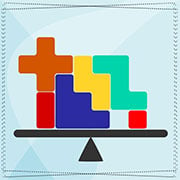Weighted Seesaw: Your Guide to Mastering Equilibrium
Welcome to the intricate and thrilling world of Weighted Seesaw, a unique physics-based puzzle game that challenges your skill, precision, and strategic thinking under the pressure of a ticking clock. This guide will equip you with the insights and strategies needed to master the delicate art of equilibrium and conquer every exhilarating stage.
Understanding the Core Mechanics
Weighted Seesaw blends intuitive physics with complex puzzle-solving. Your objective in each escalating level is to achieve perfect balance on a seesaw before time runs out.
The Seesaw and Physics
Your primary interactable element is the seesaw itself. To balance it, you must understand the interplay of weight and distance. A heavier weight placed closer to the seesaw’s fulcrum (pivot point) can exert the same force as a lighter weight placed further away. This concept of leverage is fundamental to your success.
Weights and Mass
Each level presents a variety of weights. These weights differ in mass, which is often visually represented by their size or density. Critically, pay close attention to the available weights and mentally assess their approximate “heft.” Your challenge lies in judiciously selecting and positioning these weights to offset the forces on either side of the seesaw.
The Relentless Clock
Time is your most demanding adversary. A countdown timer accompanies each level, adding an intense layer of pressure to your decision-making. You must efficiently analyze the setup, formulate a plan, and execute it to achieve equilibrium before the clock hits zero.

Strategies for Perfect Equilibrium
Conquering Weighted Seesaw requires more than just trial and error. Here are key strategies to guide your journey:
1. Observe and Analyze Meticulously
Before touching anything, pause and take in the entire level.
- Survey all available weights: Note their apparent mass and consider their potential uses.
- Assess the current state: Is the seesaw already tilted? What existing weights are in play?
- Identify constraints: Are there obstacles? Are there specific areas where weights must (or cannot) be placed?
2. Understand Leverage and the Fulcrum
The further a weight is from the seesaw’s center (the fulcrum), the greater its effect.
- Heavy Weights: If you have exceptionally heavy weights, they might best be used closer to the fulcrum to avoid drastically overbalancing a side.
- Lighter Weights: Numerous lighter weights can achieve balance by distributing them further out from the center, effectively increasing their leverage.
3. Make Incremental Adjustments
Avoid drastic, large-scale moves initially.
- Start with a hypothesis for basic balance, perhaps by placing a primary weight.
- Then, make small, controlled adjustments. Shift a weight slightly along the seesaw, or add/remove a smaller counterweight. Think of it like fine-tuning a traditional scale.

4. Prioritize Time Efficiency
The clock waits for no one. While initial analysis is good, don’t get stuck overthinking.
- Act decisively: Once you have a general plan, start executing it promptly.
- Refine on the fly: You can make adjustments as the weights settle. Don’t aim for immediate perfection with the first drop; use the remaining time to fine-tune.
- Speed matters: The less time you spend pondering, the more time you have for precise placements.
5. Learn from Every Attempt
Every failed attempt is a valuable lesson.
- Analyze the failure: What led to the imbalance or timeout?
- Identify culprits: Did a specific weight placement cause asymmetry? Was your initial plan too slow?
- Adapt your strategy: Use those insights to refine your approach for the next attempt. Don’t be afraid to experiment with different sequences or placements.
6. Think Creatively for Solutions
Some levels might require unconventional thinking.
- Stacking: Consider if stacking weights can achieve a specific balance point or fit them within a confined space.
- Dynamic placement: Sometimes, dropping a weight and allowing it to roll or bounce into position is part of the puzzle.
- Sequential Drops: The order in which you place or drop weights can dramatically alter the outcome.
Conclusion
Weighted Seesaw is a uniquely engaging puzzle experience that truly challenges your strategic mind and steady hand. By understanding its core physics-based mechanics and applying these practical strategies, you’ll be well on your way to mastering perfect equilibrium and conquering every level the game presents. Good luck, and happy balancing!